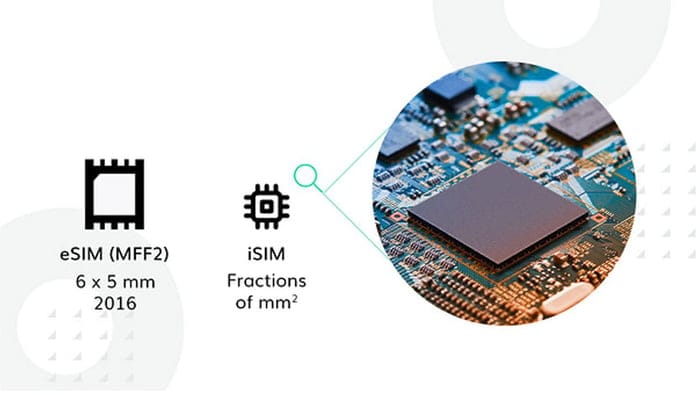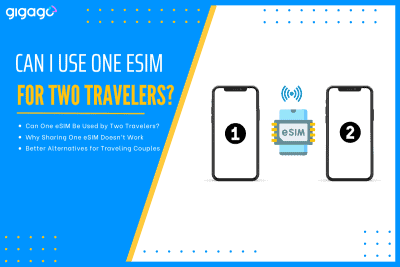Traveling for a short trip, typically for 3- to 7-days, drastically changes the rules of connectivity. The traditional solutions like expensive carrier roaming or time-consuming local SIM buying are simply impractical when time time is precious. This is where eSIMs take the picture. The eSIM (embedded because it is a digital solution that solves the […]
eSIM vs iSIM vs SoftSIM – Compare virtual SIM types
As technology moves forward, traditional physical SIM cards are being replaced by newer options like eSIM, iSIM, and SoftSIM, which are changing the way we connect to mobile networks. While these digital SIM technologies share the common goal of eliminating physical cards, they differ significantly in their implementation, security features and use cases.
In this comparison, eSIM vs iSIM vs SoftSIM, we will explore how each technology works, their key differences and help you understand which solution might be best suited for your connectivity needs as a traveler.

In this article
I. Evolution of SIM technology: from physical SIMs to virtual SIMs
The evolution of SIM technology spans over three decades, transforming from physical cards to virtual solutions.
Subscriber Identity Module (SIM) technology started with the credit card-sized physical SIM in 1991. Over the years, technology progressed through various smaller formats, with the Mini SIM in 1996, the Micro SIM in 2003, and the Nano-SIM in 2012. The real breakthrough came in 2016 with the introduction of eSIM, which enables digital profile management without physical cards.
Most recently, iSIM and SoftSIM have emerged as the next-generation solutions, offering integrated hardware and pure software implementations, respectively.
This progression highlights clear movement toward more flexible, efficient, and hardware-independent connectivity solutions.

II. What is embedded SIM (eSIM)?
An eSIM is a digital SIM chip permantently embedded into a device’s motherboard during manufacturing. Also known as MFF2, this embedded SIM cannot be physically removed or replaced. Unlike physical SIM cards, eSIM technology stores the user information and mobile plan details digitally, allowing for remote activation and management. eSIMs effectively replace physical SIM cards and are particularly beneficial for travelers who want to stay connected worldwide without switching physical cards.
How does an eSIM work?
An eSIM eliminates the need for a physical SIM card. It allows users to download, set up and activate carrier profiles remotely by scanning a QR code or using carrier apps. Once activated, the eSIM connects the device to the network, functioning exactly like a traditional SIM.
The eSIM chip can store multiple carrier profiles on a single device, allowing users to easily switch between networks without changing physical SIM cards. This feature is particularly helpful for travelers and those who need multiple phone numbers.
Which devices support eSIM?
Most modern smartphones, tablets, and smartwatches now support eSIM technology, though compatibility compatibility varies by model and even by region.
eSIM providers like Gigago offer eSIMs for more than 200 countries worldwide. You can buy the eSIM based on your destination and data usage.
Disadvantages of an eSIM
Not all phones can use eSIM – it only works on newer phones. If you want to switch your eSIM to a new phone, it is not as simple as switching out a regular SIM card. You will need to go through a more complicated process. Also, unlike regular SIM cards that you can keep as backup, eSIM is completely digital, so there is no physical backup if something goes wrong.
► See if your phone supports eSIM technology or not.
III. What is an iSIM?
An iSIM integrates SIM functionality directly into a device’s main processor or cellular modem, unlike eSIMs that require a separate chip on the motherboard. This integration saves space, reduces costs, and improves power efficiency while maintaining the same capabilities as eSIM for remote provisioning and multiple carrier profiles.
At approximately 0.12mm², iSIM is roughly 1/300th the size of a traditional Nano-SIM and significantly smaller than an eSIM (2.5mm²). While still emerging, iSIM technology is primarily used in IoT devices.
How does an iSIM work?
An iSIM (Integrated SIM) functions as an integrated component within the device’s main processor through a System on Chip (SoC), unlike eSIMs which exist as separate chips on the circuit board. The iSIM uses integrated circuits to connect with the network and, like traditional SIMs, safely stores user information while ensuring device authenticity and network reliability.
This integration provides several advantages: it supports remote provisioning for switching between carriers, operates more efficiently than traditional SIM cards, and offers enhanced security by being designed to resist logical attacks. The integration into the processor itself also results in improved power efficiency compared to eSIM technology.

IV. What is softSIM?
SoftSIM is a pure software-based SIM solution that operates without dedicated hardware components. Unlike physical SIMs, eSIMs, or iSIMs, it exists entirely as a virtual SIM stored in the device’s memory and processor, and can be downloaded directly from the cloud onto the device’s existing module.
How does softSIM work?
SoftSIM functions as a software application within the device, handling all traditional SIM operations including calls, messages, and network connectivity. It manages the Authentication Protocol Data Unit Commands and secures key materials and assets, all while following GSMA guidelines to ensure industry-standard compatibility. The technology provides users with a familiar SIM interface but eliminates the need for any physical SIM components or dedicated chips, operating entirely through software like other applications on the device.
Disadvantages of SoftSIM
SoftSIM has more security concerns than the other digital SIMs. Its lack of hardware-based protection and industry certifications makes it more vulnerable to attacks. Additionally, limited compliance with remote provisioning standards makes it less secure for IoT applications than hardware-based alternatives like eSIM and iSIM.”
V. Compare eSIM vs. iSIM vs. SoftSIM
Here is a quick comparison between eSIM, iSIM and SoftSIM in terms of basic criteria:
Hardware implementation
These technologies represent different approaches to SIM implementation. eSIM uses a dedicated chip soldered onto the device’s motherboard, while iSIM integrates directly into the device’s main processor (SoC). SoftSIM takes a completely different approach as a purely software-based solution without any hardware components.
Size and Physical Footprint
The physical footprint varies significantly among these technologies. eSIM occupies 2.5mm² of space, while iSIM requires only 0.12mm² – roughly 1/300th of a Nano-SIM. SoftSIM has no physical footprint as it exists solely as software.
Security Level
Security implementation varies by technology. eSIM provides hardware-based security through its dedicated chip, while iSIM offers enhanced security through processor integration. SoftSIM, being software-based, potentially faces more security vulnerabilities.
Power Consumption
Power consumption differs across these technologies. iSIM offers the most efficient power consumption due to its processor integration. eSIM consumes moderate power through its separate chip operation, while SoftSIM typically requires more power as it relies on the device’s main processor and memory resources.
Implementation Cost
Implementation costs vary significantly. eSIM involves moderate manufacturing costs due to dedicated hardware requirements. iSIM reduces costs through integration with existing hardware, while SoftSIM offers the lowest implementation costs as a software-only solution.
Compatible devices
eSIM is compatible with many modern smartphones, tablets, and smartwatches from major manufacturers like Apple, Samsung, and Google. iSIM compatibility is currently limited to newer IoT devices and emerging smartphone models. SoftSIM can theoretically work on any device with sufficient processing power and memory, but requires specific software support.
Flexibility
eSIM makes switching carriers easy without physical SIM swaps, though limited by hardware. iSIM offers the same features but works more efficiently as it is built into the processor. SoftSIM promises the most flexibility since it is purely software-based, but it is still in testing and not widely used yet.
Environment Friendly
All three technologies contribute to reducing plastic waste compared to traditional SIM cards. SoftSIM leads in environmental friendliness with no hardware requirements, followed by iSIM with minimal hardware needs, and then eSIM, which still requires dedicated chip manufacturing.”
VI. Which Technology Leads: eSIM, iSIM, or SoftSIM?
Right now, eSIM is the best choice for most users. It works with many popular devices, offers strong security, and is widely accepted by carriers worldwide. iSIM is newer and works well but isn’t available in many devices yet. SoftSIM offers the easiest updates and changes since it’s all software-based, but its security isn’t as strong as the others. Until SoftSIM improves its security and iSIM becomes more widely available, eSIM remains the most practical option for most people.



